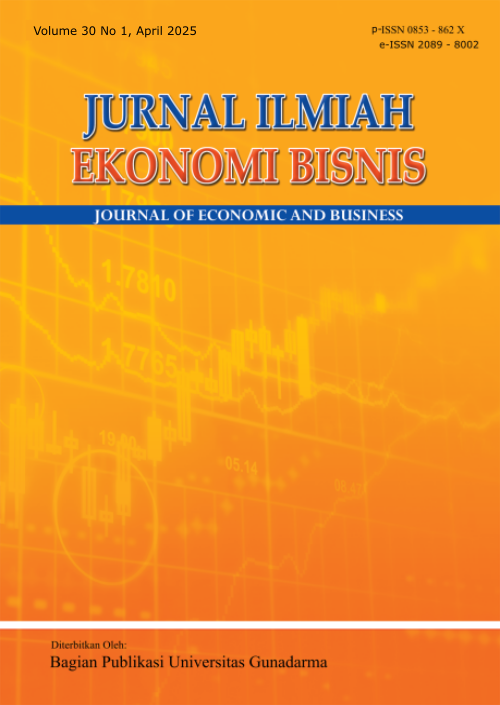DAMPAK URBAN SPRAWL TERHADAP PRODUKTIVITAS TENAGA KERJA DI INDONESIA
Politeknik Statistika STIS
Indonesia
Politeknik Statistika STIS
Indonesia
Abstract
Peningkatan urban sprawl di Indonesia cukup masif sejak perubahan sistem pemerintahan dari sentralisasi menjadi desentralisasi. Peningkatan tersebut bisa berdampak pada produktivitas tenaga kerja, namun dampaknya masih bersifat ambigu. Penelitian ini bertujuan untuk mengetahui hubungan antara urban sprawl dan produktivitas tenaga kerja di kabupaten/kota pada tahun 2022 dengan menggunakan instrumental variable - two stage least squares (IV-2SLS). Urban sprawl menggambarkan rata-rata proporsi undeveloped land di radius 1,5 km dari lingkungan tempat tinggal penduduk. Hasilnya membuktikan bahwa urban sprawl berhubungan negatif dengan produktivitas tenaga kerja, terutama di kabupaten/kota berpenduduk padat dan di Jawa. Hasil ini menyiratkan bahwa kebijakan anti urban sprawl di kabupaten/kota berpenduduk padat dapat meningkatkan produktivitas tenaga kerja. Kabupaten/kota dengan urban sprawl rendah cenderung menarik penduduk berpendidikan tinggi. Ini mungkin menyebabkan produktivitas di kabupaten/kota tersebut tinggi. Selain itu, urban sprawl dikaitkan dengan upah yang rendah. Perusahaan yang berada di urban sprawl bisa memiliki produktivitas yang lebih rendah, namun kerugian tersebut sebanding dengan pembayaran upah yang rendah ke tenaga kerja. Meskipun demikian, urban sprawl memungkinkan tenaga kerja tinggal dekat dengan tempat kerja sehingga upah yang rendah belum tentu mencerminkan penurunan kesejahteraan tenaga kerja.
Keywords
References
An, Q., Gordon, P., & Moore, J. E. (2014). A note on commuting times and city size: Testing variances as well as means. Journal of Transport and Land Use, 7(2), 105. doi.org:10.5198/jtlu.v7i2.427.
Andong, R. F., & Sajor, E. (2017). Urban sprawl, public transport, and increasing CO2 emissions: the case of Metro Manila, Philippines. Environment, Development and Sustainability, 19(1), 99–123. doi.org:10.1007/s10668-015-9729-8.
Baum-Snow, N. (2007). Did highways cause suburbanization? The Quarterly Journal of Economics, 122(2), 775–805. doi.org:10.1162/qjec.122.2.775.
Bernard, A. B., & Jones, C. I. (2001). Comparing apples to oranges: productivity convergence and measurement across industries and countries: reply. American Economic Review, 91(4), 1168–1169. doi.org:10.1257/aer.91.4.1168.
Burchfield, M., Overman, H. G., Puga, D., & Turner, M. A. (2006). Causes of sprawl: A portrait from space. The Quarterly Journal of Economics, 121(2), 587–633. doi.org:10.1162/qjec.2006.121.2.587.
Cahyadi, R. (2017). Rusli Cahyadi: Urban Sprawl, Ketidakmampuan Pemerintah dan Kota Tunggang Langgang. Retrieved from: https://kependudukan.lipi.go.id/id/berita/liputan-media/418-rusli-cahyadi-urban-sprawl-ketidakmampuan-pemerintah-dan-kota-tunggang-langgang
Carlino, G. A., & Voith, R. (1992). Accounting for differences in aggregate state productivity. Regional Science and Urban Economics, 22(4), 597–617. Diperoleh dari doi.org:10.1016/0166-0462(92)90004-K.
Carruthers, J. I., & Ulfarsson, G. F. (2003). Urban sprawl and the cost of public services. Environment and Planning B: Planning and Design, 30(4), 203–522. Diperoleh dari doi.org:10.1068/b12847
Ciccone, A., & Hall, R. E. (1996). Productivity and the density of economic activity. The American Economic Review, 86(1), 54-70.
Civelli, A., Gaduh, A., Rothenberg, A. D., Wang, Y. (2023). Urban sprawl and social capital: evidence from Indonesian cities. The Economic Journal, 133(654), 2110–2146. doi.org:10.1093/ej/uead032.
Combes, P.P., Duranton, G., Gobillon, L., & Roux, S. (2010). Estimating agglomeration economies with history, geology, and worker effects. Chicago: University of Chicago Press.
Costa, D. L., & Kahn, M. E. (2000). Power couples: changes in the locational choice of the college educated, 1940-1990. Quarterly Journal of Economics, 115 (4), 1287-1315. doi.org:10.1162/003355300555079.
Fallah, B. N., Partridge, M. D., & Olfert, M. R. (2011). Urban sprawl and productivity: Evidence from US metropolitan areas. Papers in Regional Science, 90(3), 451–472. doi.org:10.1111/j.1435-5957.2010.00330.x.
Glaeser, E. L. (1998). Are cities dying? Journal of Economic Perspectives, 12(2), 139–160. doi.org:10.1257/jep.12.2.139.
Glaeser, E.L. & Kahn, M.E. (2004). Chapter 56 - Sprawl and urban growth. Handbook of Regional and Urban Economics, 4(2004), 2481-2527. doi.org:10.1016/S1574-0080(04)80013-0
Glaeser, E., & Mare, D. (1994). Cities and skills. doi.org:10.3386/w4728.
Jaffe, A. B., Trajtenberg, M., & Henderson, R. (1993). Geographic localization of knowledge spillovers as evidenced by patent citations. The Quarterly Journal of Economics, 108(3), 577–598. doi.org:10.2307/2118401
Jordan, S., Ross, J. P., & Usowski, K. G. (1998). U.S. suburbanization in the 1980s. Regional Science and Urban Economics, 28(5), 611–627. doi.org:10.1016/S0166-0462(98)00016-7
Knaap, G., Ding, C., & Hopkins, L. D. (2001). Managing urban growth for the efficient use of public infrastructure: Toward a theory of concurrency. International Regional Science Review, 24(3), 328–343. doi.org:10.1177/016001701761013240
Lee, W. H., Ambrey, C., & Pojani, D. (2018). How do sprawl and inequality affect well-being in American cities? Cities, 79, 70–77. doi.org:10.1016/j.cities.2018.02.023
McCann, P. (2007). Sketching out a model of innovation, face-to-face interaction and economic geography. Spatial Economic Analysis, 2(2), 117–134. doi.org:10.1080/17421770701346622
Mills, E. S. (1967). An aggregative model of resource allocation in metropolitan area. The American Economic Review, 57, 197–210.
Partridge, M. D., Rickman, D. S., Ali, K., & Olfert, M. R. (2009). Agglomeration spillovers and wage and housing cost gradients across the urban hierarchy. Journal of International Economics, 78(1), 126–140. doi.org:10.1016/j.jinteco.2009.02.004.
Polidoro, M., Lollo, J. A. de, & Barros, M. V. F. (2012). Sprawling and urban transportation system: impacts in the city of Londrina, Parana, Brazil. International Journal of Sustainable Development and Planning, 7(3), 317–332. doi.org:10.2495/SDP-V7-N3-317-332.
Prasertsoong, N., & Puttanapong, N. (2022). Regional wage differences and agglomeration externalities: micro evidence from Thai manufacturing workers. Economies, 10(12), 1-22. doi.org:10.3390/economies10120319.
Rigby, D. L., & Essletzbichler, J. (2002). Agglomeration economies and productivity differences in US cities. Journal of Economic Geography, 2(4), 407–432. doi.org:10.1093/jeg/2.4.407.
Sveikauskas, L. (1975). The productivity of cities. The Quarterly Journal of Economics, 89(3), 393-413. doi.org:10.2307/1885259.
Syaban, A.S.N., & Appiah-Opoku, S. (2024). Unveiling the complexities of land use transition in Indonesia’s new capital city IKN Nusantara: A multidimensional conflict analysis. Land, 13(5), 1-36. doi.org:10.3390/land13050606.
USDA. (22 June 2020). Natural amenities scale. Retrieved from: https://www.ers.usda.gov/data-products/natural-amenities-scale/.
Wheeler, C. H. (2001). Search, sorting, and urban agglomeration. Journal of Labor Economics, 19(4), 879–899. doi.org:10.1086/322823.
World Bank. (2024). Employment in agriculture (% of total employment) (Modeled ILO Estimate))—Indonesia. Retrieved from: https://data.worldbank.org/indicator/SL.AGR.EMPL.ZS
Yunita. (2020).Urban sprawl dan obesitas: studi empiris di Indonesia (Master thesis). Universitas Indonesia, Depok, Indonesia. Retrieved from: https://lib.ui.ac.id/detail?id=20507017&lokasi=lokal
Zhao, Z., & Kaestner, R. (2010). Effects of urban sprawl on obesity. Journal of Health Economics, 29(6), 779–787. doi.org:10.1016/j.jhealeco.2010.07.006



